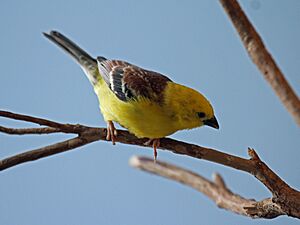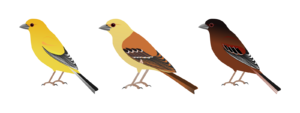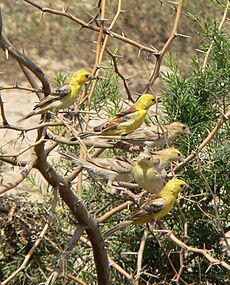Sudan golden sparrow facts for kids
Quick facts for kids Sudan golden sparrow |
|
|---|---|
 |
|
| A male in the National Aviary, Pittsburgh, U.S. | |
| Conservation status | |
| Scientific classification | |
| Synonyms | |
|
The Sudan golden sparrow (Passer luteus) is a small, bright yellow bird found in parts of Africa. It's known for its beautiful golden feathers. People sometimes keep these sparrows as pets because they are good at singing. That's why they are also called the golden song sparrow.
This bird belongs to the sparrow family. It is sometimes thought to be the same as the Arabian golden sparrow. Both are often called "golden sparrows."
Contents
About the Sudan Golden Sparrow Name

A scientist named Martin Lichtenstein first described this bird in 1823. He found a specimen in Dongola, Sudan. He first named it Fringilla lutea.
Later, it was placed in the group of birds called Passer, which includes many sparrows. The name luteus means "saffron yellow" in Latin. This fits the bird's bright color.
Golden Sparrows: A Family Resemblance
The Sudan golden sparrow looks a lot like the Arabian golden sparrow. They are so similar that some people think they are the same species. Both are also similar to the chestnut sparrow.
You can tell them apart by their colors. The male Arabian golden sparrow is almost completely gold. The male chestnut sparrow is mostly brown. The male Sudan golden sparrow is in between, with yellow and brown parts.
These three sparrows act in similar ways. They have learned to live in dry places where conditions can change a lot. For example, the males do a special dance to attract mates. They shake their wings above their bodies. This helps keep their bird colonies together.
What Does the Sudan Golden Sparrow Look Like?

The Sudan golden sparrow is a small bird. It is about 12 to 13 centimeters (5 inches) long. Its wings can spread about 5.7 to 7 centimeters (2.2 to 2.8 inches) wide.
Male birds are easy to spot. They have bright yellow heads and bellies. Their wings and backs are a deep chestnut brown. They also have two white stripes on their wings. During the breeding season, their colors get even brighter. Their beaks change from a dull horn color to shiny black.
Female birds are lighter in color. They are pale sandy-buff with yellowish faces. Their wings are light brown. Their backs have faint brown streaks. Their bellies are pale yellow, fading to whitish.
Young sparrows look like females, but they are a bit grayer. About 10 weeks after hatching, young males might start to show some yellow feathers.
Sudan Golden Sparrow Calls
This sparrow makes a basic "chirp" or "tchirrup" sound. It sounds like other sparrows. They also have a more song-like call. Sometimes, they make a fast, rhythmic "che-che-che" sound.
Where Do Sudan Golden Sparrows Live?
The Sudan golden sparrow lives in Africa, south of the Sahara Desert. You can find them from Senegal in the west to Sudan and Ethiopia in the east.
In 2009, a group of seven was even seen in Morocco. This bird likes dry, open areas. It lives in savannas, semi-deserts, and dry scrublands. It also lives in places where cereals are grown.
Sudan Golden Sparrow Behavior and Life Cycle
The Sudan golden sparrow is a very social bird. It likes to live in large groups. These groups often move around a lot. They might join other birds that eat seeds, like red-billed queleas.
In the evenings, huge groups of these sparrows gather to sleep. Sometimes, hundreds of thousands of birds roost together in cities like Khartoum.
What Do They Eat?
These sparrows mostly eat seeds. They also eat some insects, especially when they are feeding their young. They prefer grass seeds. This includes small cereal seeds, like those from millet.
When kept as pets, they are fed a mix of grains and vegetables. They also eat mealworms and other healthy foods.
Reproduction and Nesting
Sudan golden sparrows breed in very large groups. These groups can have as many as 65,000 nests!
Their nest is big and looks a bit messy. It's shaped like a dome and made of twigs. They build it in tree branches. Inside, the nest is lined with soft feathers.
They usually lay one or two sets of eggs each year. Each set typically has three or four eggs. The eggs are white with dark spots.



